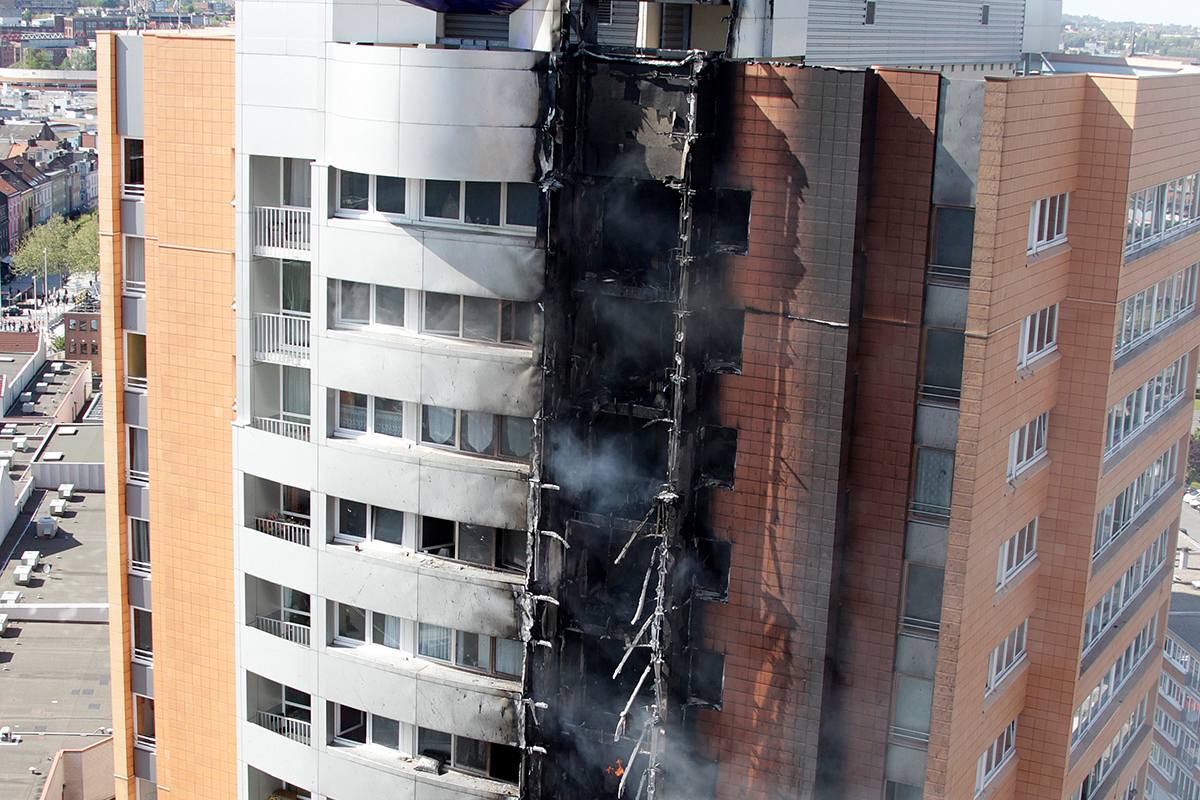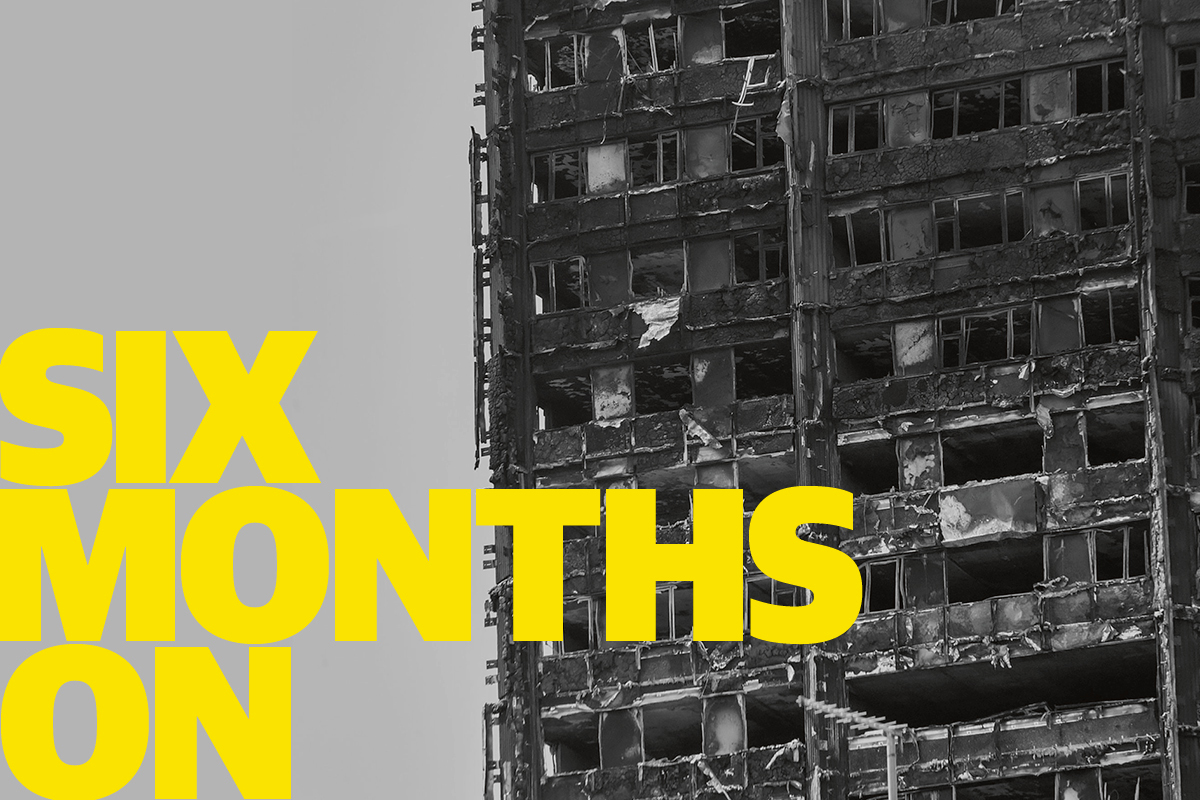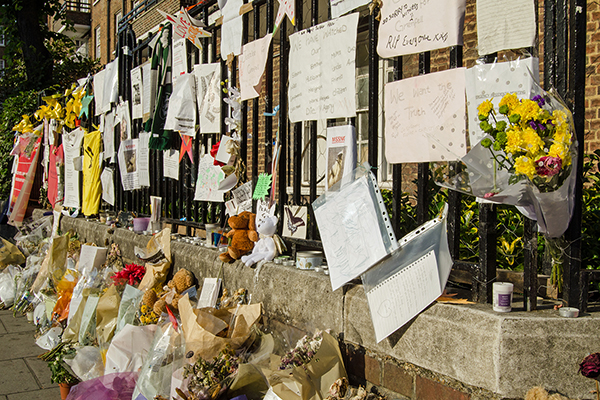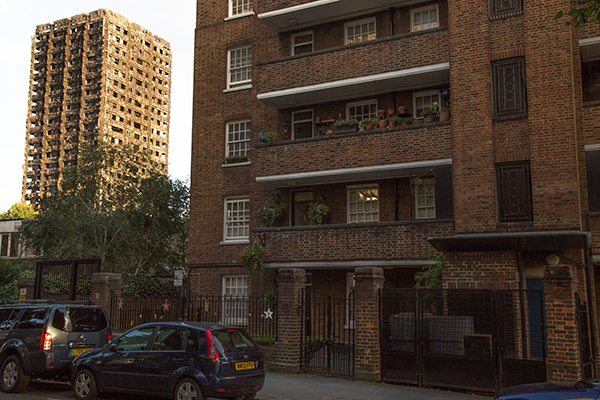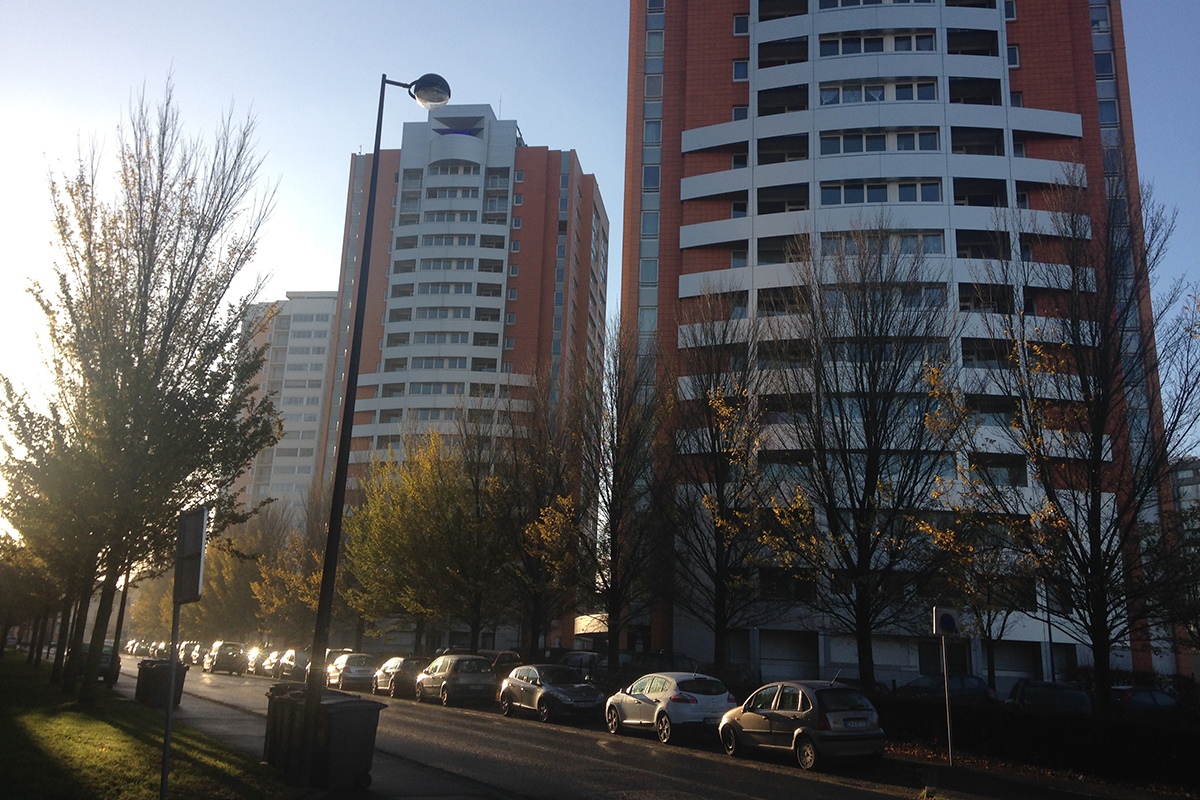Grenfell: the French connection
It’s a familiar story: a fire raged through the cladding of a social housing block. But the year was 2012 and the location was northern France. Kate Youde finds out more. Photography by Reuters and Kate Youde
A fortnight after a tower block fire forced them from their old home, Danielle and Mekki Ferchichi moved into their new one.
“They were good, very fast,” says 60-year-old Ms Ferchichi, in French, of their social landlord.
The couple were at work when the blaze broke out in the high-rise block Mermoz, in the French city of Roubaix, on a sunny afternoon in May 2012. A YouTube video filmed (see below) by someone living nearby recorded the rapid spread of the fire, which started on a first-floor balcony.
The Ferchichis, who lived on the floor where the fire started, stayed with family for two weeks before being rehoused in an adjacent block, called Guynemer.
Inside Housing has travelled to Roubaix to find out more about the fire, in which one person died, and to see whether there are lessons landlords in the UK can learn from what happened.
Roubaix, about nine miles from Lille in northern France, is known to cycling fans as the finish for the historic Paris-Roubaix race over cobblestones. The city played an important role in the textile industry but has suffered since its decline: Roubaix’s unemployment rate is 30.9% compared with 14% for France, according to 2014 census data, the most recent statistics available.
We visit on November’s Black Friday. Even before stores at the McArthurGlen Designer Outlet have opened, a festive soundtrack is playing to entice shoppers: “Have a holly, jolly Christmas; it’s the best time of the year.”
On a parallel road overlooking the mall is the 18-storey Mermoz, the middle of three concrete blocks with terracotta tiles, built in 1970.
A fourth sits on the opposite side of the road. All are named after famous French aviators.
The 33,000-home social landlord Lille Métropole Habitat (LMH) bought three of the four – Mermoz, Guynemer and Blériot – in 1999. Four years later, it installed Alucobond PE –sheets of aluminium with a polyethylene core – to the towers during renovation work because there were leaks in the façade and for insulation purposes (see timeline). “The windows, the frontage was in bad condition,” says Alain Didaux, who is in charge of operations for LMH.
A piece of this cladding is lying on the table in front of Inside Housing when we meet three LMH employees, speaking a mixture of French and English, in a ground floor room at Mermoz used by construction workers.
The block remains empty five-and-a-half years after the fire, which LMH estimates equates to a loss in rental income of €5m (£4.5m) for the landlord. The blaze started on a first-floor balcony but the cause is as yet unknown. A legal inquiry into the fire is ongoing.
There has been speculation, as with the Grenfell Tower fire six months ago, that the building’s cladding allowed the fire to spread quickly. “But it was not our fault,” says Florence Guiot Carlier, who is in charge of communications for LMH, “because we had the right to put that cladding [on] in 2003 because it was permitted [under French rules]”.
A spokesperson for 3A Composites, manufacturer of Alucobond, reiterates this: “The fire in Roubaix is subject to a legal inquiry. The official technical experts… have confirmed that the renovation of the façade, including the cladding material, was compliant [with] the building regulations in place.”
Watch a video of the Roubaix fire
He stresses that Alucobond as siding material is one component of external wall construction and that other factors need to be taken into consideration with regard to fire safety: insulation material; sub-constructions, in particular with respect to the depth of the cavity; fire barriers to block the fire spreading in the cavity; installation complying with tests; cladding material; and sprinklers and fire escape routes.
LMH felt it had two choices: to evacuate residents from Guynemer and Blériot – the other two blocks with the same aluminium cladding – or to change the cladding. It went for the second option. Two years ago, it spent €1.5m over 14 months removing the cladding and installing new Alucobond A2 panels. Residents, who were informed but not consulted about the renovation, remained in the towers during the work.
The new cladding looks the same as the old Alucobond PE aluminium composite material but is made differently. It has a mineral core.
But why did LMH decide to re-clad the blocks? “We wanted to go quickly and we wanted to respect the architecture and the view, so we just changed to have the same but better,” says Ms Guiot Carlier.
And are they confident the new material is safe? “The European rules show us that it’s OK,” says Ms Guiot Carlier. “No problem.”
She is referring to the Euroclass system. A2 is a European class, which equates to a definition of limited combustibility in Approved Document B of UK building regulations.
Frédéric Varlet, director of repairs at LMH, adds, in French, that tests in Europe are “more draconian” than French standards. As a result of the fire, LMH chose to use a material that met European standards, although French law did not oblige the landlord to do so.
LMH has 20 other blocks as high as Mermoz, Guynemer and Blériot but none had the same cladding.
The inquiry into the fire is ongoing but LMH has received approval to repair the fire damage at Mermoz. Work began in June to change the cladding and renovate the block. It is expected to take 20 months and cost the landlord €5m – covered, in part, by insurance.
However it is unlikely that any of the residents who were living in Mermoz in 2012 will return, as all were permanently rehoused elsewhere. Ninety-five of the block’s 102 flats were occupied at the time of the fire, in which an older, disabled woman died.
“Polyethylene is petrol. You can’t stop fire with water when it comes from petrol.”
She lived on the 15th floor and could not use the lift to escape. “When the firemen come, it’s a rule when there is a fire they cut the electricity,” explains Ms Guiot Carlier.
The remaining 94 families included 144 people. Ms Guiot Carlier says the agency that manages LMH’s apartments in Roubaix found these people temporary accommodation on the day of the fire and then worked to find permanent solutions. (LMH owns 10 agencies which each manage between 3,000 and 4,000 of its homes).
More than 50 families were permanently rehoused in less than a fortnight – in other LMH properties in Roubaix or Villeneuve-d’Ascq, about six-and-a-half miles to the south, with other social landlords or in private housing – and 18 decided to leave the area or social housing. The remaining families were permanently rehoused in less than 90 days. LMH was unable to tell Inside Housing what it spent on temporary accommodation.
Residents “were not so angry” with LMH, says Ms Guiot Carlier. “We took care of them. We found solutions.”
All tenants (there were no leaseholders) were insured – it is obligatory in France for renters to have home insurance – so Ms Guiot Carlier says they did not lose much financially. “They knew that we were not responsible,” she adds. Mr Varlet suggests this is perhaps thanks to the YouTube video.
Firefighters arrived on the scene quickly. However if the tower was one storey higher, LMH would have to have firefighters permanently on site. Under French regulations, all buildings higher than 50 metres must have three firefighters on site at all times, meaning nine firefighters per day.
Jean-Charles du Bellay, head of the fire safety department at the Fédération Française du Bâtiment (French building federation) and advisor to the safety director for the minister of the interior, admits this is very expensive. But Grenfell Tower was 67 metres high and he suggests that fire would not have happened in France.
Click here to read more about our fire safety campaign
From their experience, what advice can LMH’s staff offer UK landlords? “Replace that,” says Mr Varlet, pointing at the cladding on the table.
Ms Guiot Carlier adds: “I can say that they have to take care to communicate where there’s a problem. It’s important to take time to find another house [for residents] as quickly as possible, not [leave] the people without news. Be on the ground… as often as possible.”
The renovation in 2003 had allowed LMH to meet the latest fire safety standards. Improvements included a smoke ventilation system in the hallway, which extracted the smoke outside from the stairway.
However the blocks did not – and do not – have sprinklers. Despite the national debate about sprinklers in the UK following the Grenfell Tower tragedy, the LMH colleagues say there has been no similar discussion across the Channel. “Polyethylene is petrol,” says Mr Varlet, inferring that sprinklers may not have helped in the Mermoz fire. “You can’t stop fire with water when it comes from petrol.” And, he says in French, the new cladding is inflammable.
His colleagues say there are yet to be changes in French law as a result of the fire. However they feel change will come regarding the classification of materials and what can be put on the exterior of buildings. “Now the reflection is bigger after the Grenfell fire, here in France also,” says Ms Guiot Carlier.
Roubaix’s towers: a timeline
1999
Social landlord Lille Métropole Habitat (LMH) buys the Mermoz, Guynemer and Blériot tower blocks
2003
LMH clads the blocks as part of renovation work
2012
A fire at Mermoz kills one person
2015
LMH starts work to replace the cladding on Guynemer and Blériot
2017
LMH starts work to replace the cladding and repair the damage at Mermoz
Grenfell: six months on
We have published a series of articles to mark the six month anniversary of the Grenfell Tower fire, which killed 71 people on 14 June.
Click on the links below to read the pieces:
Six months on from Grenfell, what has changed? Our news team looks at the progress made since the fire
Grenfell: the survivors' stories Read moving speeches to MPs from four people who survived the fire
Councils have no information on privately owned tower blocks It is not just social housing blocks councils need to keep an eye on when it comes to fire safety
Disguised by luxury: fire safety flaws in private blocks revealed Our research challenges Sajid Javid's suggestion a Grenfell-style fire couldn't happen in a luxury block
We need to go much further on fire safety Our editor Emma Maier outlines Inside Housing's view on the state of play
Half of high rises could get sprinkler refit We reveal the sector's projected spend on fire safety improvements since the disaster
The French connection The parallels between a fire in France and the Grenfell tragedy
Less than half of council tower blocks assessed since Grenfell Our exclusive research reveals the state of play regarding councils' fire risk assessments
Circus therapy for children affected by Grenfell How a group offering circus activities is bringing the community together
Dangerous cladding to be removed from giant modular tower blocks Housing association Notting Hill Housing is to spend £8m to remove dangerous material on six of its blocks
